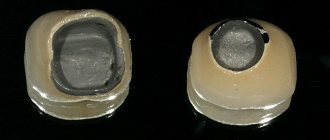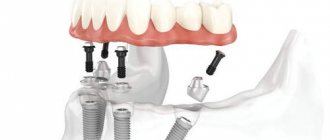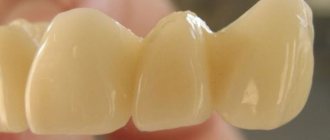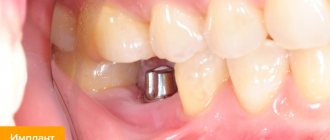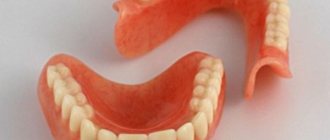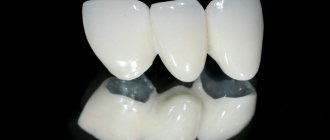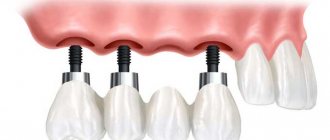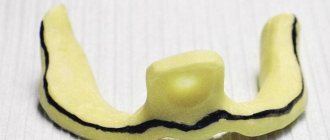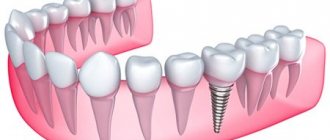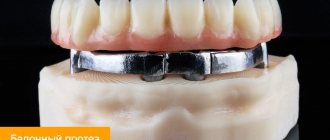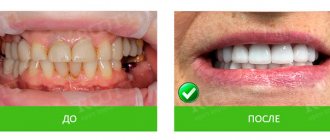1550
The complex procedure of dental implantation includes not only such components as the implant and the prosthesis itself.
An important role is played by the connecting part - the abutment, which is an integral part of a high-quality procedure.
This detail will be discussed in more detail below.
General overview
An abutment is a support for dental implants, which is the connecting link between the rod and the denture.
The connecting element is screwed onto the implant only a few weeks or months after the insertion of the rod.
This interval between manipulations is necessary to ensure that the gum tissue recovers and is not subject to additional injury.
An abutment can be made from various materials and have different configurations, depending on where it will be installed, what functions it will perform, and the characteristics of the patient’s jaw.
For each brand of implant, abutments are manufactured individually to ensure maximum compatibility.
The following types of abutments are distinguished by variety:
- standard - have different variations in the length and size of the angular cone;
- straight - in most cases, convenient for prosthetics and correspond to the standard dental procedure;
- angular (conical) - allow you to fix the crown at a maximum angle for the greatest naturalness;
- ball-shaped – for fixing removable orthopedic structures;
- gum formers are a healing structure necessary to prevent infection during implantation.
Installing an abutment is a surgical process, but it is much simpler and more painless than installing an implant. Both before and after this procedure, it is necessary to observe intervals in order for the gums to heal.
Types of abutments and their differences
All connecting structures come in two types:
- standard,
- individual.
Standard – models of permanent and temporary abutments, mass-produced in the factory. Their advantages:
- compliance with the standard,
- relatively low price,
- range of models of different lengths,
- two values of the angle of the upper cone,
- installation accuracy.
The disadvantages of standard elements include:
- they do not repeat the tooth configuration,
- production technology contains significant tolerances,
- it is possible to push through the gums,
- Sometimes it becomes necessary to surgically correct the gingival margin.
According to the functions they perform, abutments are of the following types:
- 6 standard types, 4 of which differ in length and 2 of which differ in the angle of the upper cone. This variety allows you to select, based on the bite, a device for a specific patient.
- Angular – allows for a tilt of the longitudinal axis of 30 degrees. This is necessary for the most believable imitation of a tooth. There are two options for the length of the cylindrical section.
- Spherical - used for mini-implantation, has a round shape.
- The gum former is a temporary element. Installed after surgery to restore the natural shape of the gums and prevent infection. Popular among dentists for two-stage implantation. First, a temporary former is installed, which is replaced with an abutment.
- Individual – made according to a computer model of the patient’s tooth, taking into account the characteristics and wishes of the customer.
READ IN DETAIL: gum former during implantation - what is it?
Features of the material
The zirconium abutment has high mechanical strength, as well as anatomical and individual structure. They are much stronger than standard abutments, and at the same time they are highly aesthetic.
In addition, the element has the following properties:
- high wear resistance due to the mechanical strength of the material;
- hypoallergenic and high biological compatibility;
- durability and comfort in use.
Zirconium structures are made using injection casting technology and can be one-piece.
This provides not only a high quality finish, but also additional strength which makes the possibility of damage to the abutment extremely unlikely.
In addition, zirconium has the ability to transmit light , which makes it similar in properties to real teeth. This improves the aesthetics of the smile, since the structure does not show through the implants.
Abutments made of zirconium dioxide, like other metal-free structures, are indispensable in the smile area, because they do not create gaps between the gum and the attachment and look as natural as possible, while having the necessary strength.
What materials are they made from?
- Titanium - universal, durable. They last a long time, are easy to install, and are relatively cheap. Indicated for implantation of the chewing zone.
- Zirconium - durable, aesthetic. White, almost invisible, suitable for reconstructing the smile area. Mostly solid cast.
- Ceramic - hypoallergenic with a choice of shades.
- Gold - used for attaching crowns, bridges, and beam prostheses. Ceramic-on are gold abutments lined with feldspar ceramic, ideal for esthetic restorations.
- Plastic ones are cheap and unreliable for temporary fixation.
- Combined - durable, stable with a high level of aesthetics. Most often titanium-zirconium.
Popular Dental Abutment Materials
Titanium structures can be seen through the crown, which must be taken into account when prosthetics are applied to the front teeth.
Titanium based production principle
Zirconium abutments on a titanium base are classified as combined bonding structures. This allows you to combine the strength of metal with the visual aesthetics of ceramics , combining the beauty of a smile with the reliability of the structure.
Titanium in combined bonding structures is used as a base, which corresponds to the standard one and correlates with the implantation scheme.
The body of the holder, which is part of the abutment design, is made of zirconium dioxide according to an individual design for each patient. Thus, the abutment takes the entire load on the titanium base , without being visible through the prosthesis, thanks to the zirconium body of the holder.
CAD/CAM technology allows for precise milling of the body of the holder according to an individual design for each patient.
This allows the structure to hold the prosthesis as well as a natural tooth root could.
Features of the All on 6 implantation technique and main advantages.
Come here if you are interested in the process of making a surgical template for implantation.
At this address https://www.vash-dentist.ru/implantatsiya/metodiki/tehnika-beskrovnoy.html we will talk about bloodless implantation.
What does an abutment look like?
An abutment is a small structure that is installed on an implant .
After this, a prosthesis is placed on it. Before installing the abutment, the doctor must make sure that the implantation operation was successful. When the abutment is screwed in, the patient walks with it for a week so that the tissue calms down after the operation and returns to its normal state. And only after this the dentist installs an artificial tooth. Installation of the structure is quick and all you need is local anesthesia. What it looks like: first, an implant is inserted into the gum, which acts as a tooth root . It is not even visible beyond the gum line. Then the abutment is screwed in and it is worth noting that there is nothing like that in the tooth structure. It looks like a metal pin that rises above the gum, but it should not be higher than the other teeth located nearby. And only then the denture is installed.
It is worth knowing that the abutment requires careful care. In the first day after it is screwed in, you cannot touch it, because this causes severe pain. Therefore, care should be abandoned. The dentist will usually prescribe a mouth rinse at this time. After 2-3 days, the swelling of the gums will begin to subside and at this time it is worth starting proper care. This is necessary to avoid complications and infection entering the gums.
Sometimes it happens that after three days the gum still hurts and, in addition, fluid begins to come out . In such cases, you need to immediately contact a specialist; there is a possibility that an abscess has started and it needs to be treated correctly. But if you delay a visit to the doctor, the abutment will begin to wobble and may break, while the gum becomes infected, and the structure should be urgently replaced.
The implant abutment can have a different design, everything depends on the patient’s wishes, treatment and implantation method. Remember, the abutment must be protected, because it is not a prosthesis yet and it is also not worth subjecting it to load. It is better to choose soft food and rinse your mouth with an antiseptic solution every time after eating.
Main differences
The connecting element made of zirconium differs from titanium in almost all respects for the better.
As already mentioned, it has a serious advantage over its metal counterparts, if only in that it does not allow the formation of gaps between the gum and the attachment.
This is important not only from an aesthetics point of view, but also from a safety point of view. Cement getting into the gap during implantation can lead to inflammation, and the implant may simply not take root.
In addition, custom-made zirconia structures perform much better than standard titanium connectors.
They cause minimal discomfort, are absolutely inert and do not cause additional discomfort in the patient.
As mentioned earlier, zirconium structures are indispensable when implanting the front teeth in the smile area, since titanium structures shine through the dentures at a certain angle, depriving the appearance of naturalness and revealing the presence of prosthetics.
The only disadvantage of zirconium structures over titanium products is their high cost.
Often, if it is necessary to replace a large number of dental units, the patient is offered a compromise option - the most visible teeth are replaced with zirconium structures, and the others with titanium ones.
At what stage of implantation is the abutment installed?
Dental implant installation is a surgical procedure performed under local anesthesia in a standard (two-stage) or one-stage manner.
Two-step installation algorithm:
- Inserting the implant, screwing in the plug.
- Suturing the structure located under the gum.
- Engraftment of the metal root (3-6 months).
- Surgical opening, removal of the plug.
- Screwing in the former for 2 weeks.
- Removing the former and installing an abutment in its place .
- Fixation of an artificial crown.
Installing an angled adapter is no different from installing a straight one, but requires more time and care. This is due to the increased difficulty of screwing the metal root into the jaw bone at the desired angle so that the crown or bridge does not come out of the dentition.
The permanent adapter can be fixed immediately after the introduction of the titanium rod, bypassing the stage of attaching the former. A temporary crown is installed on it, which will help form the correct gum contour. One-piece systems are implanted in one stage, then crowns are put on. Deviations from installation standards are possible according to the patient’s indications and wishes.
Indications and contraindications
A clear indication for installation is metal intolerance in the patient. Titanium, even being an inert metal, in rare cases can cause an individual intolerance reaction.
The zirconium element can be installed even in cases of periodontal disease. Designs made from this material are indicated for people who have reduced oral immunity and are prone to various types of allergic reactions and inflammations.
The products do not have specific contraindications, but the same restrictions apply to them as for any other connecting structures.
For example, it cannot be installed during bruxism, deep bite, or during pregnancy. In addition, zirconium structures have appeared on the market relatively recently and have not yet had time to stand the test of time.
Some patients with complex jaw deformities are also unable to receive dental implants. This is not specifically related to zirconium structures, but is a limitation to their installation.
Evaluate the result of gum surgery after implantation using patient photos.
In this publication we will talk about dental implantation methods for diabetes.
Here https://www.vash-dentist.ru/implantatsiya/metodiki/zubov-pri-parodontoze.html we will tell you how implantation is carried out for periodontitis.
If a temporary abutment is installed, is a healing abutment necessary?
The temporary adapter acts as a gum former. Its installation is a desirable procedure for implanting anterior and posterior teeth. The design protects the socket from the penetration of bacteria and forms a neat cuff of connective tissue in the volume necessary to tightly grip the crown.
Why a temporary abutment during gum formation?
The gum contour on healthy teeth has clear boundaries. After tooth extraction, periodontal tissues atrophy, lose their elasticity and shape. Loose gums are not able to reliably grip an artificial tooth, as a result of which food debris gets into the resulting pockets, causing inflammatory processes. To restore lost gum functions, a forming element is used, the installation of which precedes prosthetics.
How to install it on an implant and how long it is worn
The structure is attached after osseointegration is completed, approximately 4-6 months after implant installation. The doctor dissects the mucous membrane, cleans the head of the implant and installs a former in place of the plug. The process of forming strong connective tissue around the product takes about 2 weeks, then the structure is replaced with a permanent one.
Manufacturers' offers
Today, zirconium abutment is produced by several manufacturers, each of which has an individual approach to the production of bonding structures.
Below are the main offers from the largest brands.
Straumann
The German brand Straumann offers models of the Lokator system, which, due to their design, increase the possibility of installing removable dentures.
The connecting structures of this system provide double fixation and are capable of self-regulation. This increases the speed of installation of the prosthesis while maintaining reliable fixation .
Zirkonzahn
Zirkonzahn is a brand that currently produces more than 100 types of implant systems.
Their zirconium abutments are produced according to individual designs, allowing you to create the most comfortable system for each patient, and are tailored for use with implants of the same brand.
ETGAR
The brand can offer many models both in shape (straight, angular) and materials.
Zirconium abutments, in addition to permanent ones, are available from the manufacturer in a version for temporary installation.
The manufacturer guarantees quality, durability and good survival of structures.
M.I.S.
The bonding systems of this manufacturer include not only zirconium abutments, but also structures on a titanium base . The range includes models with different shapes and sizes.
In addition, the manufacturer offers gum formers made of zirconium.
Zimmer
The American company offers angular and straight models of zirconium abutments with and without a shoulder . The special design allows you to restore gaps in the frontal area without compromising aesthetics.
Methods of fixation on dental implants
Screw fastening
The crown is attached using a small retaining screw that is threaded through a hole created on the occlusal surface of the denture. The screw passes through the crown, through the abutment (which also has a hole), and is screwed into a special thread located inside the implant. This is how the final fixation of the external and intraosseous components of the denture occurs. And in order to solve the issue of aesthetics and hide the “tops” of the screws from prying eyes, doctors mask the chewing surface of artificial teeth with a composite material.
Straight or angular superstructures are used for this purpose. The advantage of screw fastening is the ability to remove the structure for its restoration. But screws can break, for example, due to poor-quality material or due to the lack of professionalism of the implantologist. The method is used for single restorations and complex solutions for restoring a large number of teeth using immediate loading protocols.
Cement fixation
The prosthesis is fixed using a special cementing solution and it is no longer possible to remove it - here you will only have to saw the structure (the implants, of course, remain in place). The advantage of cementing is improving the aesthetic qualities and increasing the operating comfort of the structure. It is mainly used for single restorations, less often for complex implantation (but mainly for permanent prosthetics, when there is no need to correct the installed orthopedic structure).
Rules of care
In the postoperative period, the patient must take a course of antibiotics and painkillers. Antibiotics prevent infection , and painkillers relieve unpleasant symptoms.
If your health worsens, you should contact your dentist immediately, since problems with healing may result in the structure simply not taking root, or damage to the oral mucosa.
The first time after installation of the structure, patients may feel discomfort. In order to reduce these symptoms, it is recommended not to eat solid foods for 2-3 weeks after the procedure. It is preferable to eat soups, cereals, purees, etc.
For the first 2-3 days after installation of the abutment, you can only use mouth rinses. Later, before dentures, it is necessary to take care of the oral cavity , cleaning the teeth and abutment every time after eating with a soft brush and toothpaste.
Installation
The abutment implantation procedure is the second stage of dental implantation, that is, it is performed after the installation of dental implants.
Although the operation is considered surgical, it is much less painful and easier than installing implants. During this procedure, special plug screws are removed, which are necessary for protection during the healing period. Instead of these screws, the abutment is screwed in.
After installation, a break of several weeks is required to ensure complete healing of the soft tissues, and then dental prosthetics can begin.
One of the innovative methods of implantation is transgingival express implantation, which involves installing an implant through a small puncture without incisions in the gums or sutures. This method is painless and does not cause postoperative complications: swelling, hematomas, bruises, suppuration, etc. Due to the fact that with transgingival implants the abutment is located in the dental implant, prosthetics can be performed immediately on the day of surgery.
Price
The cost of installing an abutment depends both on the design itself and on the clinic where the procedure is performed.
The choice of design depends on the individual characteristics and desires of the patient himself, and the price of the work may vary depending on the clinic and the severity of each specific case.
Thus, the approximate cost of an individual zirconium abutment can range from 3,000 to 6,000 rubles, depending on the type of design and manufacturer.
And the fee for work in various dental clinics can range from 3,500 to 20,000 rubles.
This amount does not include preliminary diagnostics and additional services such as intermediate examinations in the postoperative period. In the table you can see the prices of some models from well-known manufacturers.
| Manufacturer | Price in thousand rubles. |
| Mis | 17 |
| Zimmer | 10 |
| Straumann | 11 |
| Nobel Biocare | 9 |
| Zirkonzahn | 15 |
The video provides additional information on the topic of the article.
Price
The cost of an abutment depends not only on the design features, but also on the material of manufacture.
Let's look at the average cost of individual adapters using the table as an example.
| Material | Price in rubles |
| Titanium | From 13,000 to 15,000 |
| Plastic | From 1 800 |
| Zirconium | From 17 000 |
| Titanium/cobalt chrome alloy | From 10 000 |
| Combined | 12 000 |
Reviews
Manufacturer's descriptions of procedures and products may not always correspond to actual customer experiences.
If you or someone you know has ever had a zirconium abutment installed, share your impressions in the comments to this article.
If you find an error, please select a piece of text and press Ctrl+Enter.
Tags abutment implantation zirconium abutment
Did you like the article? stay tuned
Previous article
Swiss precision in the creation of Thommen implants
Next article
What signs indicate the inevitability of removing the crown from a tooth?
Reviews of doctors providing the service - Abutment
Words cannot express my gratitude to Elena Nikolaevna Kiseleva.
This is the best doctor in the world. I got an appointment after many years of being ignored by the dentist’s office and with the bitter experience of treatment in another paid clinic, the mistakes of which had to be corrected in the first visits. Thank you for this... Read full review Roman Stanislavovich Sh
25.07.2020
Evgeniy Borisovich, thank you very much for getting rid of that pair of eighth teeth that prevented me from living for a long time, because of which I could not explain in words what exactly was hurting me, neither to the dentist, nor to the otolaryngologist, nor to the neurologist, but you removed them in five minutes as if... Read full review
Roman Stanislavovich Sh
25.07.2020
